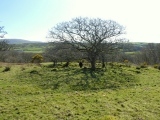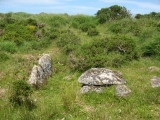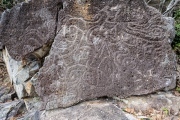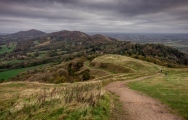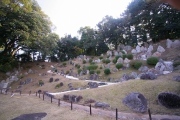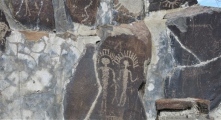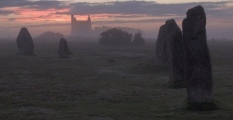Andy Burnham's Blog, page 201
April 6, 2020
Tutankhamun: Treasures of the Golden Pharaoh exhibition, Saatchi Gallery
Tutankhamun: Treasures of the Golden Pharaoh exhibition, currently at the Saatchi Gallery in London.
With the exhibition sadly closed due to the COVID-19 virus, I am posting some pictures taken when we visited on 28th January 2020. The exhibition was due to continue until 9th May 2020, but was closed on 28th March and it is unclear whether it will be able to reopen.
With the exhibition sadly closed due to the COVID-19 virus, I am posting some pictures taken when we visited on 28th January 2020. The exhibition was due to continue until 9th May 2020, but was closed on 28th March and it is unclear whether it will be able to reopen.
Published on April 06, 2020 10:02
Pont Fadog W Hut Circle
A Roman / Iron age period hut circle quite close to the tarmacked path to Pont Fadog, Gwynedd. It is on the right hand side, clearly marked on the 1:25,000 OS map; but as the land slopes away to the west and the tree/scrub cover can be dense, it is not easily found. But on a sunny day early in the year, walk down towards the stone wall and there it is - a large donut of grass covered stones with a large tree inside.
Published on April 06, 2020 09:13
Dunnabridge Pound Farm Newtake
Only one side of this cist remains. It consists of a slab of granite standing upright to a to height of 0.75m. It is 0.8m wide and 0.2m thick and appears to be an end-stone. At its foot is a slab which is partially buried and it was impossible to take its dimensions.
Published on April 06, 2020 06:04
Cape Collinson Rock Carving
The rock carving at Cape Collinson in the Eastern District of Hong Kong Island was discovered in October 2018. It is located on a cliff, about 11m above sea level. A combination of geometric and sinuous designs were carved on a fairly flat weathered surface of a natural outcrop measuring about 160cm in height and 260cm in width. The designs include elements closely resembling those on Bronze Age stamped geometric pottery and the other eight rock carvings in Hong Kong.
Published on April 06, 2020 05:53
Herefordshire Beacon
The Herefordshire Beacon (aka British Camp) was constructed around the 4th century B.C. and in the centuries following, more banks and ditches were built lower down the hillside. It's unlikely that it could have withstood a long-sustained siege due to there being no natural water supply within its defences. The fort probably ceased to be occupied about 50 A.D. at the time of the Roman invasion.
Published on April 06, 2020 05:52
April 4, 2020
ex-Enyū-ji temple
On a hill in the heart of Ōmura city, numerous stones stand like penguins on a slope. This was originally a garden of a temple now collapsed away, there are also the tomb stones of martyr to the Meiji Restoration wars for whom this temple prayed. It's just 6km from Nagasaki Airport, and worth visiting.
Published on April 04, 2020 12:19
Bryn Alyn
A presentation from today's Special Offa about Caer Alyn: Wats Going On? by Alan Brown. There is still time to join the online conference at https://twitter.com/ODCollaboratory. Hillfort in Wrexham. This site is being investigated as part of the Caer Alyn community archaeology Project. Image: The southern end of the Caer Alyn hillfort. The green circle marks the southern enclosure, the area excavated in 2010. The brown circle indicates the position of the second trench, over the linear feature. Credit: Natural Resources Wales, with annotations by Alan Brown
Published on April 04, 2020 06:22
April 2, 2020
Vantage Petroglyphs
In 1963, about 60 petroglyphs were relocated to the Ginkgo Petrified Forest State Park along the Columbia River in the State of Washington due to the construction of the Wanapum Dam.
Published on April 02, 2020 10:40
Tambo Colorado
Spatial data and high quality scans and images made available for many sites via Cyark and Open Heritage 3D. An Inca adobe settlement dating from 1470 CE - 1532 CE. Many murals have been found. Tambo Colorado was a strategic Inca center, dominating access to the Inca road leading to the highlands and eventually to the Inca capital in Cuzco.
Published on April 02, 2020 05:08
April 1, 2020
The Hurlers
The triple stone circles of the Hurlers on Bodmin Moor are discussed, talking about the pathway, the circles and their links to the night sky. Video with Carolyn Kennett, archaeologist Jacky Novakoski and astronomer Brian Sheen. Linked from the comments on our page. On the wild plain of Bodmin Moor is found an unusual site - three stone circles close together. They lie on a NNE-SSW line, but are not the same size. The name "The Hurlers" refers to an old tradition that the circles are men turned to stone for playing Hurling on the sabbath.
Published on April 01, 2020 09:38


